Geology of Iceland - Part 6: Volcano types
Introduction
Volcanism in Iceland is very diverse. Nearly all volcano types and eruption styles that we know of can be observed on the island [1]. The volcano types range from flat mafic shield volcanoes to conical-shape stratovolcanoes. Volcanic activity itself varies from effusive to explosive and occurs in subaerial, subglacial and submarine environments [2]. Effusive basalt eruptions form the dominant volcanic activity, but explosive eruptions of subplinian and Plinian intensities characterize and shape Icelandic volcanism. Large eruptions have widespread range of effect and the largest may have had global impact.
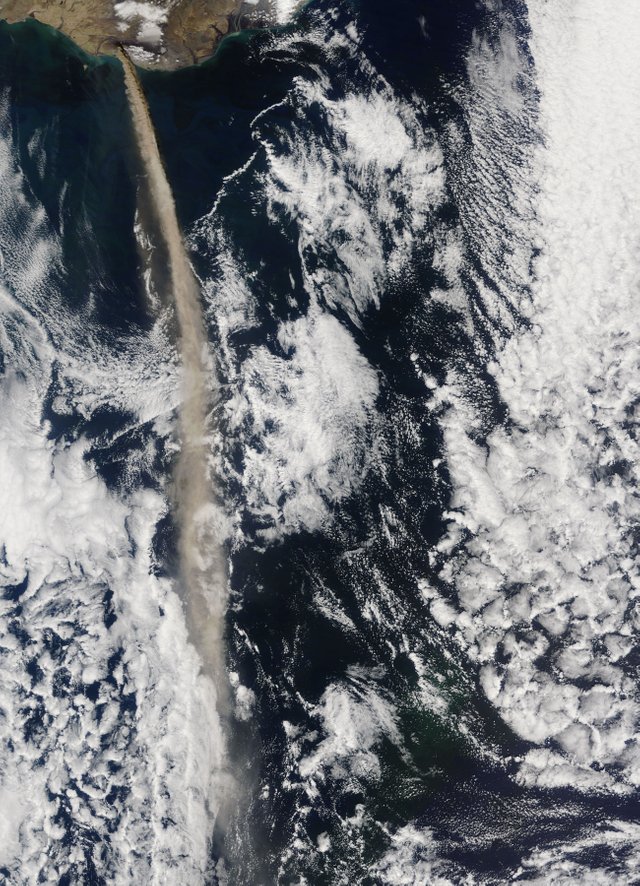
Eyjafjallajökull Volcano eruption from May 11th, 2010. The ash cloud produced by the eruption hindered air traffic at multiple locations in Europe and northern Africa.
earthobservatory.nasa.gov
What is a volcano?
The term volcano describes a system in which magmatic activity forms structures around one or more vents in either one single (monogenetic) or multiple (polygenetic) eruptions [3]. The shape of the resulting volcano is dependent on the type of the erupting magma, the repeated activity of the eruptive system, the shape of the vent system as well as the environment the eruptions are taking place in. This leads to a wide range of exposed forms, from simple cracks in the ground to the high rising stratovolcanoes that probably first come to mind when someone mentions the word volcano.
On Iceland two broad types of volcanoes can be defined, central volcanoes and basaltic volcanoes. Both types are described here.
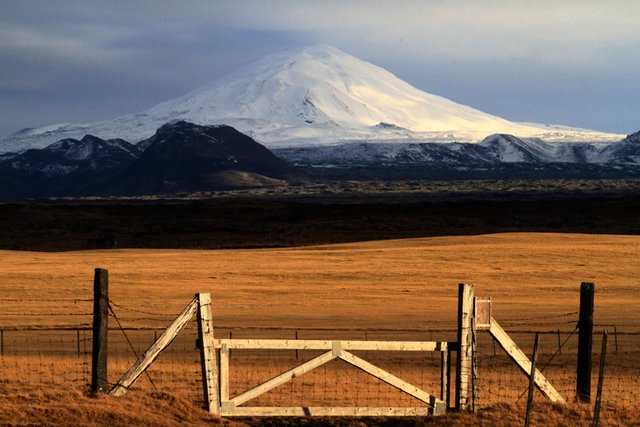
Front view of Hekla.
Photo by Sverrir Thorolfsson, flickr.org
Central volcanoes
The central volcanoes that pop out of several volcanic systems form by multiple eruptions from a central vent that taps into a long-lived plumbing system. At the central volcanoes, the lava escapes through circular vents within the summit caldera or along short fissures that occur radially around the caldera along the flanks of the volcano [4]. The construction of Tertiary (>2.58 Ma) volcanoes on Iceland is dominated by basaltic magmatism, with smaller intermediate to felsic components [5]. Pyroclastic material is only a minor component (~5%) of these volcanic structures. Because of the lava dominated eruption style, their overall morphology resembles Hawaiian shield volcanoes, although the amount of intermediate and felsic components is usually higher in the Icelandic systems [5].
The more modern volcanoes differ from their older counterparts due to the interaction with ice that once covered the complete island and is still a dominant feature on Iceland. The volcano-ice interaction creates volcanoes that are characterized by a series of alternating layers of lava flows and pyroclastic deposits [6]. A total of ten volcanoes in Iceland are formed this way and their shape resembled neither the shield-, nor the stratovolcano.
Five central volcanoes form beautiful stratovolcanoes, with steep (15-33°) flanking slopes and a summit crater or small caldera on top.
Two central volcanoes form gentle slopes and display large (10-18 km) calderas. These volcanoes resemble modern continental andesite-rhyolite caldera volcanoes [7].
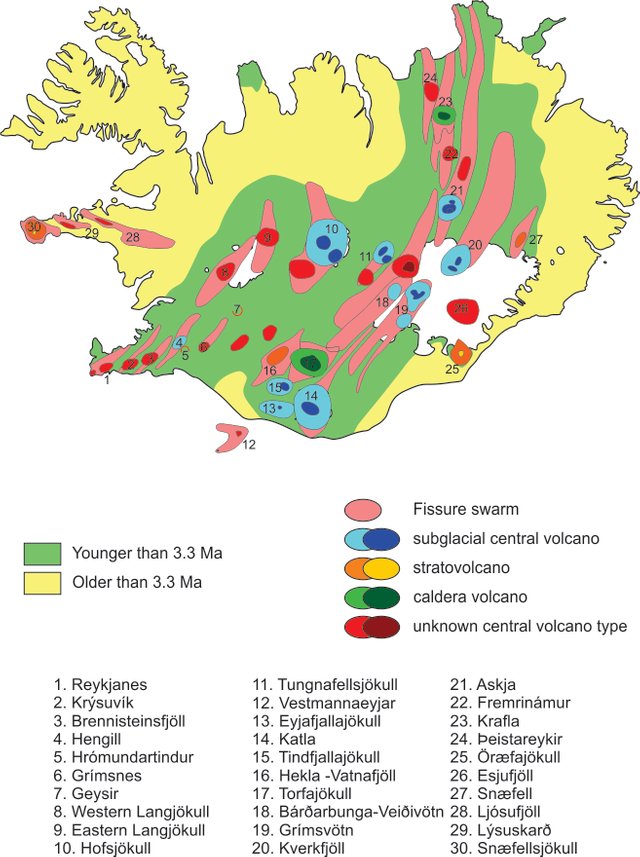
Simplified tectonic map of Iceland with central volcanoes labelled according to their volcano type.
Simplified after Jóhannesson and Sæmundsson (1998). Based on data from The Icelandic Institute of Natural History (license). Volcano types from Thordarson and Larsen (2007). Names of volcanic zones from en.wikipedia.org.
Basalt volcanoes
The fissure swarms on Iceland are dominated and characterized by monogenetic basalt volcanoes [2]. Their shape varies depending on the accompanied vent system. These vent systems can be a linear or a point source. Linear vent sources are also labelled fissures. They can grow multiple hundreds of kilometers in length, whereas the point source vents usually only show crater diameters around one kilometer.
In addition to their vent system, basaltic volcanoes are characterized based on their eruption environment and the consequent eruption material. They include subaerial magmatic volcanoes, subaerial phreatomagmatic (hydromagmatic) volcanoes, as well as subglacial and submarine volcanoes.
Subaerial monogenetic volcanoes form single cones above circular point vents and rows above linear vent systems. On top of circular vents, monogenetic events form lava shields, spatter rings and scoria cones. All of these are usually produced by effusive events. The majority is formed during short lived (days to months) and small-ish (<1 km3) events. Large eruptions (>1 km3) are rarer and, where present, form large, symmetrical shield volcanoes [8]. They are the product of long lasting (years to decades) events that are constantly fed by sustained lava lakes in the summit vent.
Skjaldbreiður (meaning “the broad shield”).
Photo by fingalo, commons.wikimedia.org
Linear subaerial magmatic volcanoes or volcanic fissures are the trademark of Icelandic volcanism [2]. They form a row of often densely packed cones that can vary in size from a few meters to more than one hundred meters [9]. The row can be underlain by a single fissure or be the representation of multiple, staggered fissures. These cones are composed of spatter and scoria like their circular vent counterparts. Spatter and scoria are each formed by small volumes of erupting material (<0.5 km3). But more often mixed cone rows are produced. As the name indicates, these represent a mixture between the former two types. Mixed cone rows are the most common type of linear eruptions on Iceland [9]. They come in all sizes (0.0 – 20 km3) and vary from short lived (days to weeks) to long-lived (months to years) events. The two largest eruptions on Iceland are of this type [2].
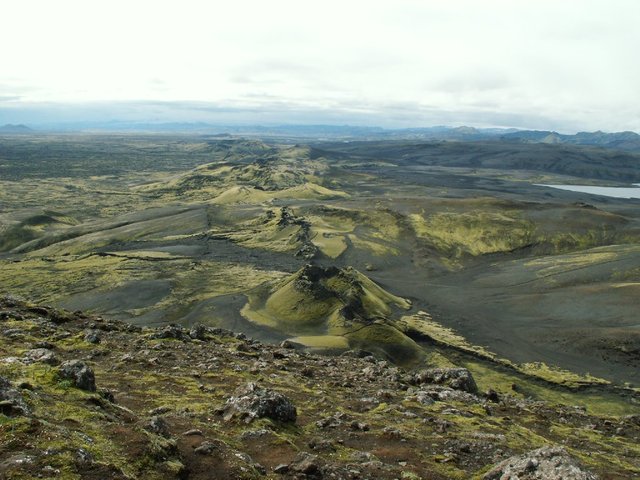
Laki volcanic ridge
Photo by Ulrich Latzenhofer, flickr.com
Subaerial monogenetic phreatomagmatic eruptions form tephra or tuff cones and rings around circular vents and tephra or tuff cone rows along linear vents. If the resulting explosion craters get filled with water, they are termed maar volcano [10].
Tuff cones belong to the largest circular point vent monogenetic volcanoes. They form circular to horseshoe shaped cones, with wide craters (up to 1 km) and high (up to 150 m) crater walls. Tephra cone rows form up to 30 km long linear volcanoes that are up to 2 km wide (Unfortunately, I cannot find open access images but here is a very nice photo of one).
Hverfjall tuff cone at Mývatn
Photo by Hansueli Krapf, commons.wikimedia.org
Subglacial and submarine monogenetic volcanoes are widespread in Iceland [2]. They embody the point and linear vent features that have been formed in the Quaternary (2.58-0.012 Ma) as well as current day examples within and beneath remaining glaciers.
If the water or ice pressure above this type of volcano is high enough, the erupting lava forms pillow basalts [11], which are represented as cones or as ridges. If volcanic activity continues, magma pushes its way into the ice sheet, where they form móberg cones. If magmatic activity continues even further and the magma pushes its way through the ice sheet, effusive activity resumes (like in the previous mentioned subaerial volcanoes). At this stage the volcanic edifices formed are called tuya, impressive structures with very steep flanks.
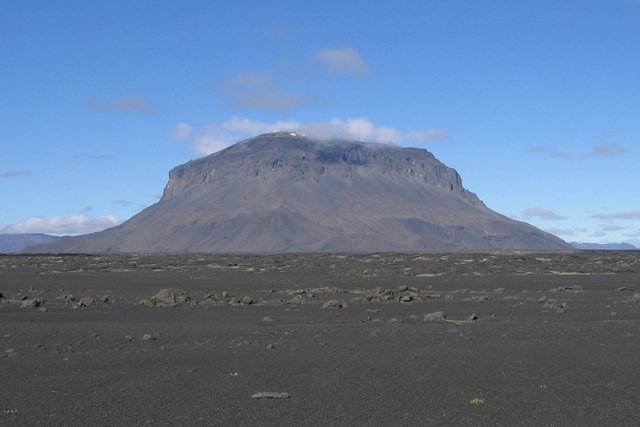
The mountain Herðubreið, a tuya that formed beneath the ice sheet during the last glacial period.
Photo by Icemuon, commons.wikimedia.org
Previous posts
Geology of Iceland - Part 1: Introduction
Geology of Iceland - Part 2: The Iceland hotspot
Geology of Iceland - Part 3: an island being ripping apart
Geology of Iceland - Part 4: volcanic Systems
Geology of Iceland - Part 5: Magmas and Rocks
References
[1] Thorarinsson, S. and Sæmundsson, K. (1979). Volcanic activity in historical time. Jökull 29, 29–32.
[2] Thordarson, T. and Larsen, G. (2007). Volcanism in Iceland in historical time: volcano types, eruption styles and eruptive history. Journal of Geodynamics 43, 118-152.
[3] Francis, P. and Oppenheimer, C. (2004). Volcanoes. Oxford University Press, Oxford, 521 pp.
[4] Gudmundsson, A. (2000). Dynamics of volcanic systems in Iceland: example of tectonism and volcanism at juxtaposed hot spot and mid-ocean ridge systems. Annual Review of Earth and Planetary Sciences 28, 107–140.
[5] Blake, D.H. (1970). Geology of the Alftarfjordur volcano, a Tertiary volcanic centre in south-east Iceland. Scientia Islandica 2, 43–63.
[6] Macdonald, G.A. (1972). Volcanoes. Prentice-Hall Incorporation, Englewood Cliffs, NJ, 510 pp.
[7] Walker, G.P.L. (1984). Downsag calderas, ring faults, caldera sizes, and incremental caldera growth. Journal of Geophysical Research 89, 8407–8416.
[8] Rossi, M. (1996). Morphology and mechanism of eruption of postglacial shield volcanoes in Iceland. The Bulletin of Volcanology 57, 530–540.
[9] Thorarinsson, S. (1981). Jardeldasvædi á nútíma (Volcanic areas of the Holocene). In: Náttúra Íslands, 2nd ed. Almenna bókafélagid, Reykjavík, 81–119.
[10] Lorentz, V. (1973). On the formation of maars. The Bulletin of Volcanology 37, 183–204.
[11] Höskuldsson, A. and Sparks, R.S.J. (1997). Thermodynamics and fluid dynamics of effusive subglacial eruptions. The Bulletin of Volcanology 59, 219–230.
https://en.wikipedia.org/wiki/Maar
https://en.wikipedia.org/wiki/Tuya
https://en.wikipedia.org/wiki/Her%C3%B0ubrei%C3%B0#cite_note-1

Iceland has been on my bucket list for a while now. I am hoping to get there next year. The geology looks amazing but I think I will go just to soak in the thermal pools.
Currently Iceland is probably my top destination, should I ever get enough money saved in the next year to justify an actual vacation :P
I don't think one can visit Iceland without soaking in the pools. The blue lagoon looks amazing. But I would also like to experience the smaller, more local, pools. But I guess it's harder to find those.
And while I am still sitting in my warm little apartment I want to say I will also dip into glacier water. But we need to see if I stay with that bold statement once the first toe hits the actual water...
There is certainly much more to think about with regards to volcanoes than one first imagines.
Indeed! They are fascinating systems. If I'd now only be smart enough to understand physical volcanology as well. I believe I'd be even more amazed by them.
Did you saw that you won at my giveaway: https://steemit.com/giveaway/@jeanpi1908/results-of-my-steemit-anniversary-giveaway
Hi @sooflauschig!
Your post was upvoted by utopian.io in cooperation with steemstem - supporting knowledge, innovation and technological advancement on the Steem Blockchain.
Contribute to Open Source with utopian.io
Learn how to contribute on our website and join the new open source economy.
Want to chat? Join the Utopian Community on Discord https://discord.gg/h52nFrV
You received a 80.0% upvote since you are a member of geopolis and wrote in the category of "geopolis".
To read more about us and what we do, click here.
https://steemit.com/geopolis/@geopolis/geopolis-the-community-for-global-sciences-update-4
Interesting how a small island like Iceland can have so many volcanoes, I wonder if that country is at risk because of the presence of so many volcanoes?
In the last 1000 years over 200 eruptions have taken place. Some of them have caused death, while others only caused damage to cities and farms.
But there is always danger associated if you decide to live on a volcanic island.
Wow that is very good and informative post. I do like it. I get more knowledge from your post. I will be waiting your best post again...